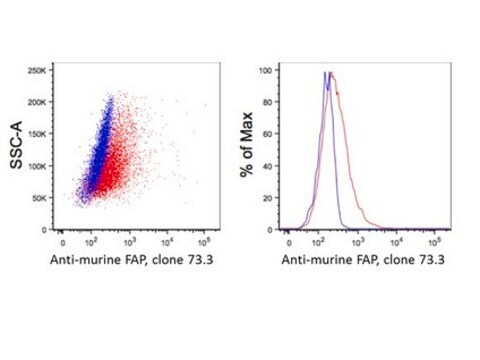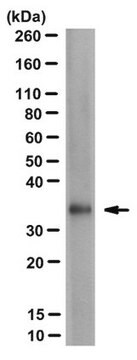MABN784
Anti-FMR1polyG Antibody, clone 2J7
clone 2J7, from mouse
Sinónimos:
Fragile X mental retardation protein 1 RANT fusion, FMR1polyG, FMRP RANT fusion, FMR-1 RANT fusion
About This Item
Productos recomendados
origen biológico
mouse
forma del anticuerpo
purified immunoglobulin
tipo de anticuerpo
primary antibodies
clon
2J7, monoclonal
reactividad de especies
human
técnicas
immunocytochemistry: suitable
immunohistochemistry: suitable
western blot: suitable
isotipo
IgG2bκ
Nº de acceso UniProt
Condiciones de envío
wet ice
modificación del objetivo postraduccional
unmodified
Información sobre el gen
human ... FRAXA(2477) , FRAXA(108684022)
Descripción general
Especificidad
Inmunógeno
Aplicación
Immunohistochemistry Analysis: A representative lot detected both ubiquitinated inclusions-associated and non-inclusions-associated FMR1polyG immunoreactivity by dual fluorescent immunohistochemistry using paraffin-embedded brain tissue sections from Fragile X-associated Tremor/Ataxia syndrome (FXTAS) patients (Todd, P.K., et al. (2013). Neuron. 78(3):440-455).
Western Blotting Analysis: A representative lot detected recombinant FMRpolyG GST fusion constructs, while only one immunoreactive band (~15 kDa) could be detected in Fragile X-associated Tremor/Ataxia syndrome (FXTAS) patients brain lysates due to extended aggregation of FMR1polyG (Todd, P.K., et al. (2013). Neuron. 78(3):440-455).
Immunocytochemistry Analysis: A representative lot detected exogenously expressed FLAG-FMR1polyG constructs by fluorescent immunocytochemistry (Todd, P.K., et al. (2013). Neuron. 78(3):440-455).
Neuroscience
Neurodegenerative Diseases
Calidad
Western Blotting Analysis: 1.0 µg/mL of this antibody detected an exogenously expressed FMR1polyG GFP fusion construct in transfected COS cells.
Descripción de destino
Forma física
Almacenamiento y estabilidad
Otras notas
Cláusula de descargo de responsabilidad
¿No encuentra el producto adecuado?
Pruebe nuestro Herramienta de selección de productos.
Opcional
Código de clase de almacenamiento
12 - Non Combustible Liquids
Clase de riesgo para el agua (WGK)
WGK 1
Punto de inflamabilidad (°F)
Not applicable
Punto de inflamabilidad (°C)
Not applicable
Certificados de análisis (COA)
Busque Certificados de análisis (COA) introduciendo el número de lote del producto. Los números de lote se encuentran en la etiqueta del producto después de las palabras «Lot» o «Batch»
¿Ya tiene este producto?
Encuentre la documentación para los productos que ha comprado recientemente en la Biblioteca de documentos.
Nuestro equipo de científicos tiene experiencia en todas las áreas de investigación: Ciencias de la vida, Ciencia de los materiales, Síntesis química, Cromatografía, Analítica y muchas otras.
Póngase en contacto con el Servicio técnico





